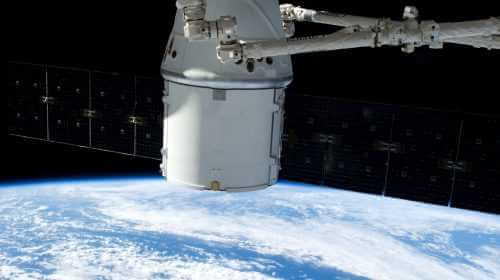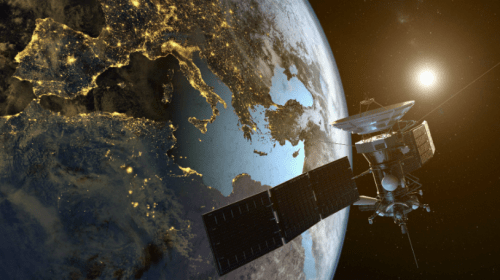Oct 19, 2018
As the commercial development of space proceeds full speed ahead, we’ve examined some of the issues that will face companies such as OneWeb, Telesat and Starlink (SpaceX), as they develop and launch new LEO (Low Earth Orbit) satellite constellations that are intended to compete with terrestrial broadband, and deliver services to the many in the world who remain without internet access. Among these issues are the Kessler Syndrome which could render LEO unusable due to the growing problem of space junk that could cascade into a maelstrom of collisions. We’ve also discussed the capacity these new satellites will deliver and noted that it’s not terribly significant in the grand scheme of things. We’ve discussed FPA (flat panel antenna) technology and ground infrastructure requirements. What other issues might exist for NewSpace?
 Artist’s impression of the thousands of objects in orbit around Earth.
Artist’s impression of the thousands of objects in orbit around Earth.
Licensing
A significant risk factor became evident when Russia refused to give OneWeb permission to deliver it’s broadband-by-satellite service over their country. What the refusal was based on is difficult to say. Russia indicated that it was concerned about collisions with other satellites, but Russia’s space agency Roscosmos had already granted OneWeb permission to operate its initial system of 720 spacecraft. Some have suggested that the denial of licensing was a result of the ongoing trade war between the US and Russia. This is one example of the many risks that the “internet for all” LEO constellations are bound to encounter. While the technical challenges are being addressed and met one after the other, there are several other barriers to success. Planning to deliver services to over 190 countries, each with its own concerns (such as corruption and politics), not to mention competition from existing GEO (Geosynchronous Earth Orbit) satellites, the new LEO satellites, and a rapidly expanding fiber infrastructure on earth, presents quite a formidable challenge.
To send signals down from a satellite to a nation, licensing is normally required for “landing rights” or the ability to land a satellite’s signal in a designated country. Every country that the LEO broadband satellite providers wish to service must provide these landing rights. In addition, these satellite constellations require gateways on earth that receive the signals from the LEO satellites and place the traffic on the internet backbone. Licensing for these gateways can be even more intense and difficult to obtain. Some NewSpace vendors are proposing satellite-to-satellite links that can relay traffic to a satellite passing above a gateway. In this way, fewer gateways are required. Companies like OneWeb, which do not have this inter-satellite connectivity will require more gateways, and hence will encounter more licensing issues. Placing gateways in as many as 50 countries, will probably also include paying high spectrum fees – making the services less competitive.
Achieving a rapid ramp up of the business, and the need to generate early positive cash flow will lead to cherry-picking countries that will be supportive and provide friendly regulatory environments. This may result in a piecemeal approach, based on racing time to ensure early cash flow and sustain a long-term business. The recent licensing denial by Russia, also shrinks the size of the market, and hence the revenue required to make this model work.
Spectrum
Another potential problem is that other countries may be interested in launching their own LEO platforms. In that event, why wouldn’t those countries make it more difficult for competitors to offer services in their countries? China, for example has explored the possibility of a joint venture with Russia to launch a LEO constellation that would compete with OneWeb. Denying licenses would lock out competitors such as OneWeb, making their business model even more challenging.
GEO satellites are fixed in position and the satellite owners obtain landing rights for a piece of spectrum. Unlike GEO licensing, since LEO satellites move over the entire country, licensing of LEOs means giving up the rights of Ku or Ka-band spectrum over an entire country. This is likely to lead to additional licensing denials, according to some industry experts. Some industry professionals have noted that giving up this spectrum, which each country controls, would lead to interference with terrestrial radio transmitters. It would probably also lead to the development of a “toll” that providers would pay to use the spectrum – further decreasing profits for the business model.
The Market
The Mega-LEOs as they are being referred to, often tout philanthropic goals of providing service to the underserved, however the realities suggest this market may not be profitable. Given that this is a new endeavor, there is no market data to show how long it will take to penetrate the market, rendering cash flow and revenue projections a best guess. When the target market is poor to begin with, the customer’s ability to pay becomes a critical factor. As microwave and fiber push ever deeper, the ability to compete for direct-to-consumer broadband subscribers looks questionable. Where people survive on incomes of $1000/yr., paying customers will be scarce.
Building the infrastructure for the direct-to-consumer market also appears to be a daunting task. It means selling, installing, servicing, billing, collecting, and doing it in hundreds of countries, some of which will be difficult or dangerous to travel in. The logistics challenge is significant. A critical piece for the direct to subscriber market is the VSAT terminal. Flat panel antennas (FPA) that track one LEO satellite going out to one horizon and handing off to another satellite coming in from the other horizon, are still quite expensive. Those prices are going to have to come down significantly to have any hope of addressing the typical consumer subscriber.
Another, perhaps more attractive market, is the backhaul market. As cellular services spread, the infrastructure requires backhaul by microwave, fiber or satellite. Having the ability to deliver low-latency, high capacity bandwidth to MNOs (Mobile Network Operators) and WISPs (Wireless ISPs), provides a hope that fiber expansion will become less attractive by comparison. For the new Mega-LEOs competition for backhaul circuits also comes from existing GEO satellites, and MEO (Medium Earth Orbit) operator O3b (a subsidiary of SES). For the LEOs using Ka band, rain-fade in the tropics will be an issue, making the higher reliability of fiber more attractive.
Competition
After dealing with licensing, spectrum, and the difficulties involved in starting a new business model, growing competition from incumbents is another barrier to consider. In addition to Mega-LEOs competing with other Mega-LEOs, growing competition comes from HTS (High Throughput Satellite) GEO satellites adding more capacity and driving down prices. Massive new satellites are on the calendar, and even SES’s O3b will have expanded its mPOWER MEO fleet. Some industry observers think this additional capacity could drive down prices, making LEO obsolete before it begins, or capable of offering at best, an incremental or niche service. The established players have subscriber bases, while the newcomers must start from scratch.
Timeframes
Unlike GEO satellites designed for longer lifetimes of 10 – 15 years, LEO satellites will need to be refreshed more often. LEO operators must achieve profitability before huge capital outlays are required to replenish the constellations. Will these constellations garner enough subscribers to sustain the business model? Hard to say. It’s all new ground…. Or perhaps we should say, “It’s all NewSpace!”
Outlook?
The NewSpace initiative for Mega-LEO constellations providing broadband services around the world, is an exciting and marketable story, but it runs up against some harsh realities – licensing, spectrum availability, infrastructure, market penetration, competition and a short time to succeed. Perhaps investment will turn from fiber expansion to 5G deployment, leaving open a window of opportunity for the Mega-LEOs to grab some market share and prove their business models. The bright and shiny vision of NewSpace’s broadband satellite plans are a bit tarnished, but it’s still holds exciting possibilities.





